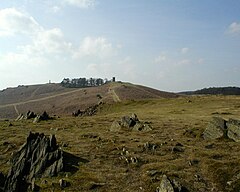Bradgate Park
| Bradgate Park | |
|---|---|

Rocks, Old John and the War Memorial
|
|
| Type | Medieval Deer Park |
| Location | Leicestershire, UK |
| Nearest city | Leicester |
| OS grid | SK529107 |
| Coordinates | 52°41′30″N 1°13′17″W / 52.6917°N 1.2214°WCoordinates: 52°41′30″N 1°13′17″W / 52.6917°N 1.2214°W |
| Area | 850 acres (340 ha) |
| Elevation | 75 m (246 ft) to 212 m (696 ft) |
| Created | 1500 (Public Park from 1928) |
| Operated by | Bradgate Park and Swithland Wood Charity (Registered Charity no. 521476, (popularly known as the Bradgate Park Trust) |
| Visitors | 900,000 |
| Open | all year, 7.45 am to dusk |
| Website | www |
Bradgate Park (local pronunciation: /ˌbrædɡʌt/) is a public park in Charnwood Forest, in Leicestershire, England, northwest of Leicester. It covers 850 acres (340 hectares). The park lies between the villages of Newtown Linford, Anstey, Cropston, Woodhouse Eaves and Swithland. The River Lin runs through the park, flowing into Cropston Reservoir which was constructed on part of the park. To the north-east lies Swithland Wood. The park's two well known landmarks, Old John and the war memorial, both lie just above the 210 m (690 ft) contour.
The area now enclosed as Bradgate Park was one of a number of parks surrounding Charnwood Forest. Since medieval times it has been part of the Manor of Groby. In the reign of Edward the Confessor, the area was owned by Ulf. The manor, along with some 100 others in and around Leicestershire, was awarded to Hugh de Grandmesnil in the eleventh century as reward for his assistance in battle to William I. The name Bradgate is thought to derive from Norse or Anglo-Saxon, meaning "broad road" or "broad gate" respectively. The first mention of Bradgate Park is from 1241, by which time it was laid out as a hunting park, although rather smaller than the current boundary. It was subsequently acquired by the Beaumont family, passing to the de Quincy family and on to William de Ferrers of Groby. It remained in the de Ferrers family until 1445, when it passed to the Grey family after William's only surviving daughter married Edward Grey. The inquisition into the estates of de Ferrers, made after his death, mentions the park, with "herbage, pannage and underwood, worth 40 shillings yearly". The Grey family retained it for the next 500 years, and in the 19th century was opened to the public several days a week. In 1928 it was bought by Charles Bennion and given, as a plaque in the park describes, 'to be preserved in its natural state for the quiet enjoyment of the people of Leicestershire'.
...
Wikipedia

